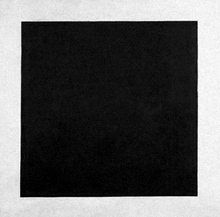The artist, Martin Creed, was interviewed this morning on BBC Radio 4’s The Today Programme. http://www.bbc.co.uk/programmes/b04982j9 He was asked the question: ‘is a piece like your ‘light going on and off’ in a room an artwork?’
The question arose as part of a discussion about the forthcoming exhibition at the Tate Modern in London about the Russian artist Kazimir Malevich whose famous painting of 1915 (1913/23 or 29) is the centrepiece of the exhibition, but which caused such an international stir when it was first seen 100 years ago for its revolutionary boldness. Malevich painted a simple black square on a canvass to take the representation out of painting and to try and show that art was about ideas and more importantly, about emotion.
Nothing like his work had been seen before and it broke with every painting convention. Representation had been played with by the impressionists, the pointillists and by Picasso, but Malevich’s work Black Square, reduced the aesthetic to a single colour or absence of colour. What caused further outrage was that he insisted that it be hung across the corner of the room (gallery). This might seem uncontroversial, but the corner was the place in Russian Orthodox tradition where religious icons would be hung.
So not only was Malevich breaking with artistic convention, but he was also challenging religious belief and habit. We are used to such pared down aesthetic nowadays, and even more shock tactics in art, but Martin Creed is still able to cause a considerable stir with his minimal artworks.
Which brings me to the Today Programme this morning; Creed was asked how he responded to criticism that his work was not art. He deftly turned this question around by saying he was not interested in whether or not people thought it was art or good or bad art, but whether people were emotionally moved by it or not. This gets around the whole debate about what is art and what is good or bad which seems to obsess large sections of the media.
So, Creed by his answer implied he was not concerned to engage the viewer in a debate about the notion, theory or practice of art, but whether someone liked it or not. It was as simple as that. Once you ask that question, you level the ground for people. You don’t need to be an artist or critic or art connoisseur to appreciate something, but simply how you respond to an artwork on a human level.
It could be possible to argue that Creed was sidestepping the question like politicians famously do especially on the Today Programme, by answering the question with a question, and then answering his own question. But, he sounded somewhat inarticulate on the Today Programme, and I could hear the producer in the programme autopsy afterwards asking who booked him as a guest when he was not a good talker on radio – something they seek above all else. But his diffidence with works illustrated a reluctance to enter into a knee jerk debate and to try and shift it to one where he could let the answer be provided by someone else. Yes it was canny, and he sounded the canny Scotsman to be sure, but he also hinted at some of the wider debate within the art world about the purpose of art and where art might be going. So 100 years on from Malevich’s Black Square, there is still plenty to say about contemporary art, maybe just not on the Today Programme, or not by an artist like Creed who is as economical with words as he is with his visual language.


